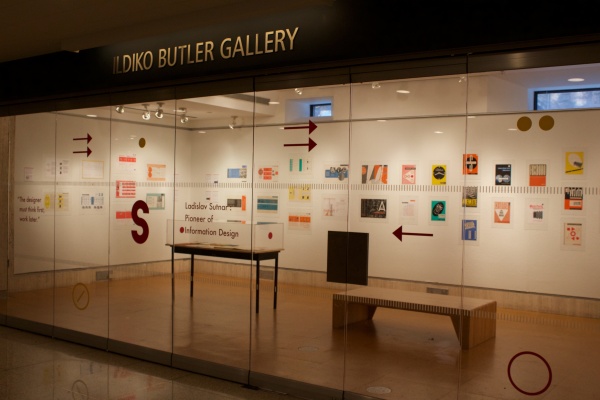A Tour of FCLC’s Art Galleries
October 23, 2015
You may have noticed the new art installation in the Ildiko Butler gallery while taking the escalators by the Lowenstein lobby. Enclosed by a glass panel is the work of Czechoslovakain graphic designer Ladislav Sutnar. Sutnar (1897-1976) spent much of his career in New York City and served as the art director for Sweet’s Catalog, a directory for building materials, products and manufacturers . Known as one who has paved the way for “modernist and constructivist ideas of the European Avant Garde,” the exhibit embodies Sutnar’s ability to display large amounts of information in a simple and accessible manner. These strategically placed displays of various information design is just one glimpse of Fordham Lincoln Center’s (FCLC) Visual Arts department.
Curated by Patricia Belen and Greg D’Onofrio, this new design exhibit is one of several outside artists brought in by Fordham professors throughout the year. Stephan Apicella-Hitchcock, gallery coordinator and artist-in-residence at FCLC, sat down with me in between painting coats of white for the gallery walls.
“We show both outside exhibitions curated by faculty as well as faculty highlight exhibitions which show three different faculty members from three different divisions. In addition, each year from mid March to mid May we have the student senior exhibitions,” Apicella-Hitchcock explained .
FCLC has a total of three art galleries, the others being the Lipani Gallery and the Hayden Hartnett Project Space. Throughout the three galleries, a variety of mediums are displayed of which include photography,film, graphic design, painting, drawing and architecture. Senior thesis exhibitions are also displayed, which “ represent the pinnacle of our undergraduates coming out of our visual arts department,” Apicella said.
The exhibitions in the Ildiko Butler gallery are mostly those organized by FCLC professors. Apicella explained, “faculty generally generates exhibitions internally so they can dovetail with our teaching pedagogy so our teachings illustrate the concepts and techniques we are trying to instill in our undergraduates.”
The artists highlighted further epitomizes the way the visual arts department hopes to encourage students to approach their artwork. More specifically, the photography department strives to get students to submerge themselves into their subject matter. “The way we teach here has a lot to do with Anthropology and Ethnography in that we really try to get people to explore their subject deeper and perform pretty sophisticated primary research,”Apicella said.
Apicella, whose paint-splattered jeans served as a testament for his investment in the three galleries, said, “We have to really compete for people’s attention in the modern age. I think everyone is really busy with their homework and study as well as their Facebook status, their Instagram accounts and other social media. On top of that, people have work study jobs and lives and families. There’s a lot of competition for people’s brains.”
With a gallery as visible as the Ildiko Butler Gallery, Apicella really hopes it welcomes those who wouldn’t normally step into an art gallery.
“Our function here is to serve the university and the greater community,” Apicella said. He went on to explain, “It’s visible, but to get people to stop and get off their phones and come in here, that’s the challenge…people see glass doors and they think stay out or they think art—precious, don’t touch, don’t go in. It’s interesting the way people’s preconceptions of how to deal with art will sometimes affect whether they feel encouraged to engage with the work.”
As Apicella and I walked down to the Lipani Gallery, he pointed out the various student exhibits, each marked with its own artistic stamp. Taken back by the professionalism and innovation exemplified by Fordham students, I was reminded of all the talent brewing at FCLC. Students have the privilege of coming and seeing the up-and-coming generation of artists’ work on display just as they’re starting to find their voice.
Much of the displays bring together various artists. “When you have a group show, you want to create a complex conversation between a number of different artists sometimes across different mediums, different ages, different generations, that maintain their own integrity. But, at the same time, start to have a dialogue with their colleagues…I’m interested in the cross-fertilization of different artists that are in the show,” Apicella said.
The exhibitions at our three different spaces encompass some of the voice of the next great artists, our fellow rams who have something valuable to share with us. “They’re meant to engage and raise questions…we’re trying to bring new conversations to light or ones that have been overlooked.”
Taking just five minutes to stop by the Ildiko Butler gallery, taking the stairs in Lowenstein to the second floor project space to see the photographs displayed or even walking a little down the hall to the Lipani Gallery is a great way to challenge and be challenged by our peers. It’s an opportunity to see what our own generation of artists have to say.













